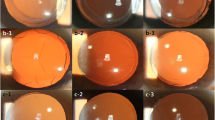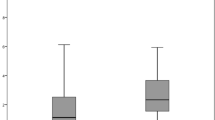Abstract
Background
Capsule defects are common during or after intraocular surgery of various kinds. The purpose of this work is to establish a classification system of lens capsule defects to provide uniform description of these defects for ophthalmic research and IOL implantation.
Methods
A retrospective study of 128 patients (156 eyes) with lens capsule injury after ocular trauma and intraocular surgery was performed. The patients were divided into two groups. Capsule defects were defined and classified according to the location, size, shape and tension of the capsule and its effect on posterior chamber IOL implantation.
Results
Lens capsule defects were classified into four types: Type I—complete capsule; Type II—incomplete capsule, but has enough area and tension to support two IOL haptics; Type III—incomplete capsule, is able to support only one IOL haptic and the other haptic needs a suture; Type IV—no capsule, both IOL haptics need suture fixation. Type I and Type II were each divided into three subtypes. Type III was divided into two subtypes. The shape of the capsule defects included fissure-like, triangle, round, irregular and fan-like. All eyes with capsule defects can be sorted into one of these types, and it is easy to guide IOL implantation according to the classification. Type II was the most common among the two groups in this study.
Conclusion
The classification of lens capsule defects is feasible and favorable for uniform clinical description, clinical research and IOL implantation.


Similar content being viewed by others
References
Angra SK, Vajpayee RB, Titiyal JS, Sharma YR, Sandramouli S, Kishore K (1991) Types of posterior capsular breaks and their surgical implications. Ophthalmic Surg 22:388–391
Vajpayee RB, Angra SK, Honavar SG, Titiyal JS, Sharma YR, Sakhuja N (1994) Pre-existing posterior capsule breaks from perforating ocular injuries. J Cataract Refract Surg 20:291–294
Skalka HW (1977) Ultrasonic diagnosis of posterior lens rupture. Ophthalmic Surg 8:72–76
Vasavada AR, Praveen MR, Nath V, Dave K (2004) Diagnosis and management of congenital cataract with preexisting posterior capsule defect. J Cataract Refract Surg 30:403–408
Nguyen TN, Mansour M, Deschenes J, Lindley S (2003) Visualization of posterior lens capsule integrity by 20-MHz ultrasound probe in ocular trauma. Am J Ophthalmol 136:754–755
Thomas R (1998) Posterior capsule rupture after blunt trauma. J Cataract Refract Surg 24:283–284
Zabriskie NA, Hwang IP, Ramsey JF, Crandall AS (1997) Anterior lens capsule rupture caused by air bag trauma. Am J Ophthalmol 123:832–833
Smith GT, Coombes AG, Sheard RM, Gartry DS (2004) Unexpected posterior capsule rupture with unfolding silicone plate-haptic lenses. J Cataract Refract Surg 30:173–178
O’Donnell FE Jr, Santos B (1985) Posterior capsular-zonular disruption in planned extracapsular surgery. Arch Ophthalmol 103:652–653
Wang HS (1986) Management of a posterior capsule rupture in planned extracapsular cataract extraction and posterior chamber lens implantation. J Cataract Refract Surg 12:73–76
Isakov I, Bartov E (1998) Managing inferior zonule tears during manual extracapsular cataract extraction. J Cataract Refract Surg 24:300–302
Yilmaz A, Baser Z, Yurdakul NS, Maden A (2004) Posterior chamber lens implantation techniques in posterior capsular rupture. Eur J Ophthalmol 14:7–13
Song Z, Hui Y, Wang L, Cao X, Gao Q (2001) Clinical observation on preservation of lens anterior capsule in reduction of complications associated with silicone oil. Yan Ke Xue Bao 17:39–41, 64 (also see p 46)
MacCumber MW, Packo KH, Civantos JM, Greenberg JB (2002) Preservation of anterior capsule during vitrectomy and lensectomy for retinal detachment with proliferative vitreoretinopathy. Ophthalmology 109:329–333
Acknowledgments
The authors thank Dr. Hung Thai and Dr. Fan-Sheng Kong for assisting with the English editing.
Author information
Authors and Affiliations
Corresponding author
Additional information
The authors have no proprietary interest in the development or marketing of any drugs or devices mentioned in this study.
Funding/Support: The investigation was supported by Zhejiang Medicine and Sanitation Grant (2002A067), Nature & Science Funds of Zhejiang Province (Y206706), Zhejiang Education Bureau Grant (20020463) and Wenzhou Science & Technology Bureau Grant (Y20060065), Zhejiang, China
Rights and permissions
About this article
Cite this article
Song, ZM., Sheng, YJ., Fu, XY. et al. Proposed classification of lens capsule defects. Graefes Arch Clin Exp Ophthalmol 245, 1653–1658 (2007). https://doi.org/10.1007/s00417-007-0614-5
Received:
Revised:
Accepted:
Published:
Issue Date:
DOI: https://doi.org/10.1007/s00417-007-0614-5




